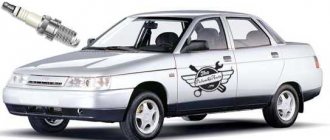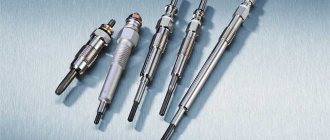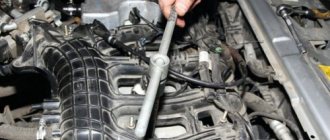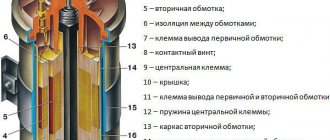The engine is flooded with spark plugs. how to return it to working condition - auto guru
Sooner or later, some motorists have to deal with the problem of starting the engine. The engine may not start at idle, even when the power unit is preheated. In most cases, there are no obvious reasons for the breakdowns to occur. This situation indicates a common reason why the engine does not want to start - fuel or oil floods the spark plugs.
Symptoms indicating flooded candles
As you know, problems with pouring candles in the warm season are not as noticeable as in winter. The list of main features includes:
- the crankshaft may rotate from the starter, but the engine does not seize;
- you will notice a distinct smell of fuel from the exhaust when the engine starts cranking;
- If you unscrew the spark plugs, traces of gasoline are visible on the threads. There is also dark carbon deposits at the bottom of the spark plugs.
It can be filled with fuel on any car model, regardless of the power system with which it is equipped. Only, comparing the carburetor and injection options, the latter is less susceptible to this phenomenon in cold weather. Individual characteristics and features of different power systems can affect flooding.
As a result of the fuel entering the combustion chamber, the spark plugs are flooded, and as a result, the fuel does not ignite. Due to the fact that the spark plugs are wet, sparking will not occur and the engine will, of course, not start.
Spark present
If you are familiar with the situation when there is a spark, but the spark plugs are flooded, and the crankshaft rotates well from the starter. Here it is necessary to check the spark plugs themselves, despite the fact that there is a spark. This may not mean that it will always happen under pressure.
Simply put, the spark will be on the unscrewed spark plug, but it may disappear after it is installed on the power unit. What causes this? In this case, the reason for this is the increase in pressure created during operation of the internal combustion engine.
The best way to determine this is through diagnostics on a special stand.
You should also pay attention to the gas distribution phases. Often their failure, various interruptions, lead to flooding of spark plugs. Injection engines can also have problems with bypass valves.
Eliminating the likelihood of such problems is possible by measuring the fuel pressure in the rail. Do not forget that fuel enters the cylinders under the influence of a certain pressure.
If there are deviations in any direction, flooding of the spark plugs is inevitable, which prevents the engine from starting.
Diagnostics is also important for injectors and ECM sensors directly. How does this manifest itself? It's simple, the temperature sensor, having detected a malfunction, sends incorrect data to the control unit. As a result, the ECU saturates the mixture and the fuel is poured into the injectors. Sometimes the power unit control unit itself may break down.
Candles and oil
There are often cases when candles are filled with oily liquid. Having noticed this, it is necessary to understand which part is susceptible to contamination. If grease accumulates in the spark plug wells, this indicates problems with the seal or valve cover gasket. Oil ingress causes a spark to pierce the cylinders, which fail.
Try unscrewing the spark plugs. If noticeable carbon deposits are visible on the threads, then oil is also leaking from the well directly onto the threads. There may be flooding at the bottom of the spark plugs - measure the compression in the engine.
Ninety percent, this indicates wear and splitting of the oil scraper rings. Another reason will be wear of the cylinder surfaces and malfunction of valve seals.
All this leads to intense penetration of lubricant into the combustion chamber, which causes the spark plugs to become oily.
Driver actions when filling spark plugs
Suppose you are sure that the engine does not start due to the presence of gasoline on the spark plugs. Therefore, you need to implement effective methods to eliminate such an unpleasant moment.
First of all, you need to dry the flooded candles. By the way, almost all car models have an instruction manual that says about drying the spark plugs if they are flooded.
First, unscrew it using a spark plug wrench, then dry it thoroughly, getting rid of traces of fuel. The next steps will be to crank the engine with the starter without spark plugs for ten seconds.
Then you can put the spark plugs in place and try to start the engine.
Another effective method for starting the engine is to blow out the cylinders. This way you can start the engine without removing the spark plugs. Blowing involves squeezing the gas pedal all the way. Then the crankshaft is cranked by the starter for about seven to ten seconds. After this, you should release the pedal. These actions lead to the start of the power unit.
Source: https://avtoguru.net/v-motore-zalivaet-svechi-kak-vernut-ego-rabochee-sostoyanie/
Flooding when there is a spark and the starter is rotating
Experienced motorists are faced with situations when a spark appears, the starter rotates, but the lower part of the spark plugs is filled with gasoline. Do not be deluded by the presence of a fire, since this event can occur irregularly under pressure and can be lost while the engine is running.
The cause of the event appears to be excessive pressure in the cylinders. It will be possible to identify the event and the factors that motivate it by monitoring the car on a stand that simulates a combustion chamber.
We recommend paying attention to the valve timing, because their failure will be the cause of wet electrodes
. In injection internal combustion engines, motorists should check the functionality of the bypass valve located on the fuel rail. If its malfunctions are ruled out, you will need to find out the gasoline pressure in the rail, because the manufacturer regulates this parameter. Sharp fluctuations and going beyond the specified interval (larger/smaller sides) can block the start of the internal combustion engine or stimulate flooding of contacts for spark ignition.
Diagnostics will need to be carried out for the sensors of the electronic control system and for the injectors. An example of a failure is when the coolant temperature sensor sends incorrect data. In such a situation, the control unit unreasonably over-enriches the fuel mixture. Much less often, the culprit of incorrect impulses is a failed electronic control unit or a malfunction of its software. In this case, problems will appear not only with the ignition.
Why spark plugs flood and what to do in such a situation
Almost every car enthusiast has at least once encountered the concept of flooding candles. This is a common problem that regularly occurs on cars of different makes, models and different years of manufacture.
You can cope with pouring candles. Moreover, car owners often do it themselves. But here it is important to first determine why exactly this happens and what kind of working fluid we are talking about.
Yes, candles can be filled with different compositions. This is directly related to how exactly the motorist will get out of the current situation.
Characteristic signs
First of all, the motorist must understand that his spark plugs are flooded. In this case, the characteristic signs of such a problem will help.
It is important to recall that the main operating cycle of an internal combustion engine is the supply of a mixture of fuel and air into the combustion chamber, which then ignites. But it happens that gasoline, if a carburetor or injector is installed, does not ignite. In this situation, they say that they fill the spark plugs with gasoline or other liquid.
This situation is due to the fact that there is too much fuel on the spark plugs. It envelops the electrode itself and the element body. The more liquid, the more difficult it is to ensure effective ignition. Sometimes this cannot be done until the candles are dried.
Often, flooding appears in winter, or frosts are approaching. That is, when it’s cold, as car enthusiasts say. This is explained by the fact that during cold weather the battery is heavily loaded.
If the battery is weak and worn out, then the likelihood of encountering flooding increases.
The driver tries to start the engine several times, nothing works, the battery charge drops even more, and the spark plugs are flooded.
Filling spark plugs is possible not only with gasoline, but also with other working fluids. These are antifreeze and motor oil.
The car owner should pay attention to the characteristic signs. They indicate oil-filled ignition system plugs. Although these symptoms are rather indirect:
- the lubricant level in the engine crankcase quickly drops;
- the engine starts unstably at any time of the year;
- dynamics drop;
- car acceleration deteriorates;
- power indicators fall;
- unstable behavior of the internal combustion engine at idle speed is observed;
- the motor is shaking.
All these symptoms can be signals of other malfunctions.
To check this fact, you should unscrew the spark plugs, check their condition visually, and look at the insulator and electrode.
If traces of oil are visible on the candles or they simply have an oil film on their surface, the conclusion is obvious.
In the case of coolant, the symptoms are similar. Power drops, the level of antifreeze in the system decreases. But a white coating already forms on the electrodes and insulator. Sometimes white smoke comes out of the exhaust pipe.
Causes
It is much more important to understand why exactly the spark plugs are flooded when they are cold, which is most typical for such a problem.
Depending on what caused the situation, appropriate measures will be taken to eliminate it.
To understand why the spark plugs in your car’s ignition system are flooding, it is important to determine what kind of technical fluid we are talking about. This could be motor oil, gasoline or antifreeze. Each of them has its own reason.
There may be several reasons. You should take a separate look at each of the presented liquids that may end up in candles.
Petrol
Understanding what it means to fill the spark plugs on a car, you need to understand the reasons for this situation. Most often we are talking about gasoline, which, due to its excess quantity, does not effectively ignite the air-fuel mixture.
There are several main reasons for this situation.
- Low battery charge. If flooding occurs when it is cold, there is a high probability that the reason lies in a discharged battery. This happens in winter and summer, but more often in cold weather due to the effect of low temperatures on the battery. When turning the key, fuel is injected, but there is no spark or its strength is not enough to ignite. Until the element is dried, it will not start.
- Fuel failure in a carburetor internal combustion engine. If it is an old carburetor, its settings may have gone wrong, which led to flooding. The carburetor supplies more fuel to the system than necessary, and the spark plugs do not have time to ignite it. In winter, if the settings are off, starting the engine will be problematic.
- Fuel failure in the injector. Here, the ECU is responsible for the fuel supply, which determines the amount of air and fuel supplied, creating a mixture, using sensors. If starting is difficult when cold, the reason should be sought in the antifreeze temperature sensors, idle air control, flow meter and throttle position sensor. Some cars use an absolute pressure sensor, which can also cause the spark plugs to flood. If there are problems with hot pouring, you should inspect the spark plugs themselves for breakdown or changes in gaps, and high-voltage wires.
- Condensation in fuel. With sudden temperature changes, condensation may form. There may also be water in the tank due to a visit to a questionable gas station. Since water does not burn, the mixture created is oversaturated with moisture and is difficult to ignite.
Quite common phenomena in the life of domestic motorists. But we cannot exclude a problem with filling with other liquids.
Engine oil
This happens quite rarely, but oil getting into the spark plugs is considered a more dangerous phenomenon. This is due to the seriousness of the reasons why the lubricant ends up there.
Oil can reach the spark plugs through the rings or through the valve. If the lubricant is on top, the reasons should be sought in leaky sealing rings of the wells or in the valve cover gasket.
The main reasons here are:
- Valve guide problems. If the working surfaces are heavily worn, play may appear in the guides. It is observed between the guide sleeve and the valve stem. As a result, the lubricant ends up in the combustion chamber on the spark plugs.
- Oil seals. Problems with valve seals cannot be ruled out. Oil passes through them for various reasons. This is a breakage of the spring, displacement of the oil seal relative to the bushing, wear of the bushing, etc.
- Rings. It would be a good idea to check the condition of the piston rings. They wear out and become stuck, and oil can flood the electrodes.
- Ventilation system. We are talking about crankcase ventilation. If it becomes dirty, the pressure inside increases and oil begins to leak out.
- Pad. This is a gasket used in the design of the intake manifold. A common problem with French cars. But it can happen on different cars.
- Oil in wells. Spark plug wells are structurally present on some cars. Here, lubricant may appear due to a violation of the tightness of the valve cover or wear of the well gaskets.
It is recommended to eliminate the problem of oil-filled spark plugs as soon as possible.
Antifreeze
Antifreeze may end up on the spark plugs for the same reasons that the coolant itself ends up in the oil.
Here we are talking about:
- damage to the cylinder head gasket;
- violation of the correct geometry of the block head;
- damage to the block itself.
Quite a serious problem that cannot be delayed.
How to fix the problem
Now you need to understand what to do if the spark plugs are filled with gasoline or other technical liquid.
In a situation where the spark plugs are flooded, it is unlikely that you will be able to start the engine easily. If the first few attempts are unsuccessful, further launches will only make the situation worse. Therefore, first you need to eliminate the provoking factor, and then try again.
We will tell you in more detail about how to start a car if the spark plugs are flooded heavily and the ignition system does not want to work. Again, it all depends on the specific liquid.
Oil
If the engine is cold or hot, and it is filled with oil, then the following actions may be required:
- if the oil in the crankcase is more than normal, drain to the required level;
- remove oil using napkins, rags or a syringe;
- burn out the remaining oil, clean the candle if you plan to reuse it;
- replace seals, guides, piston rings;
- clean the ventilation system;
- replace the intake manifold gasket.
Guides can sometimes be repaired or replaced. Oil seals are also replaced when there is severe wear, but always together with worn bushings.
Here everything depends on what kind of malfunction we are talking about. Having diagnosed why exactly when starting the engine the spark plugs are actively filled with engine oil, the cause is first eliminated, after which new or restored spark plugs are installed.
We fix the problem ourselves
To fix the problem yourself, you need to at least know where the spark plugs are. There are several solutions. The first is installing a new kit, of course, if you have one. It is advisable not to throw away the old ones, but simply put them in the garage. In order to remove the spark plugs, you will need a special one, which almost every motorist has. However, the method is not suitable for everyone, due to the lack of a new kit.
Now let’s look at a method that involves using old candles. The fact is that they are not spoiled, but simply filled with gasoline, but drying alone is also not enough. Therefore, we will need a furnace in which we can heat the candle to a high temperature and change color to red. This event is carried out in order to get rid of residual fuel and the carbon deposits that have actually formed. But here you need to remember that in this case, firstly, the ceramics of the candle will deteriorate, and secondly, polishing will be required before installation.
What to do if the spark plugs are flooded
Owners of cars with gasoline engines often face the problem of flooded spark plugs. articles:
Why does the spark plugs fill when they are hot?
This type of malfunction, such as pouring spark plugs when they are hot, rarely occurs. Basically it happens like this: the engine started well when cold, heated up to the set temperature, drove for some time and suddenly stalled.
Next, when you try to start the engine, the starter turns properly, there is gasoline, but the car does not want to start. Then, if you do nothing and leave it for a long time, the engine starts easily again.
This is a sign of flooding of candles.
Reasons why spark plugs flood when the engine is hot:
- The spark plug itself is faulty (broken; the gap is either large or small;).
- The carburetor (if equipped) is not set correctly.
- Problems with the distributor (if any).
- Faulty wiring.
- Faulty sensors (mass air flow sensor).
- The high-voltage wire is broken.
- Malfunctioning injectors.
- Problems with the software (controller or firmware).
- Operating a car with a carburetor engine with an extended choke for a long time.
The way to solve the problem of flooding spark plugs in carburetor engines is to make sure that the fuel-air mixture is lean, to do this, purge for up to 10 seconds.
A way to solve the problem of flooding spark plugs in injection engines is to blow out the cylinders by opening or partially opening the throttles.
If the spark plugs become wet in the summer, the car will start. And if it’s flooded in winter, it usually won’t start.
Signs of flooded candles are:
- The starter turns the crankshaft, but the engine still doesn’t want to start.
- When you try to start the car for a long time and the engine does not start, there is a strong smell of gasoline coming from the muffler.
- When dismantling a flooded spark plug, its thread and electrode are wet, and there is dark carbon deposits at the bottom of the spark plug, where the spark is produced.
Fills spark plugs on both injection and carburetor engines. Injection engines are flooded less frequently than engines with carburetors.
If contactless ignition is installed, then it can still contribute to the production of a spark in the candle, because contact converts energy up to 18 kilovolts, and contactless electronic up to 24 kilovolts.
If the fuel-air mixture in the cylinder misses ignition, there is a lot of it, as a result of which the fuel mixture is not able to ignite in subsequent cycles.
Reasons for flooding spark plugs of injection and carburetor engines:
- Insufficient battery charge. Sealed, maintenance-free batteries must be charged according to strict rules. Low battery charge is the reason for flooded spark plugs, mainly in injection engines, since the injector and a bunch of stuffed electronics consume a lot of energy resources, a powerful battery is needed.
- There is a problem with the ignition system. This is either broken spark plugs or high-voltage wires. Old spark plugs may produce an infrequent spark or a misfire if the tip gap is not within normal range. High-voltage wires are also often punctured if they are of poor quality.
- Gasoline is of very low quality.
Nowadays, private gas stations are common; it is enough to obtain the appropriate permits and start selling fuel. As a rule, no one checks the quality. Therefore, you should refuel at reputable large gas stations. Due to bad gasoline, condensation collects in the fuel system.Problems with starting a car in the cold season with low-quality fuel are especially noticeable.
The electronic control unit of the injection engine determines the outside temperature and the engine temperature, determines the oxygen content of the air flow entering the engine.
Next, the control unit sends a signal to the injectors to increase the supply of injected fuel, which helps create a rich fuel-air mixture for reliable engine starting in cold weather.
Why doesn't the car start from auto start? It could be frost, or maybe ignorance of a little trick.
Cars with high mileage have a certain wear of parts of the cylinder-piston group; compression in the cylinders, accordingly, becomes less, but within acceptable limits. With low compression, when the spark plugs are flooded, it is more difficult for the engine to start. With high compression, if the spark plugs are working, the fuel-air mixture can still ignite, even if the fuel is not of high quality.
Low compression, thick engine oil, weak battery - all this makes it difficult to start the engine. The following happens:
- low quality fuel is supplied;
- the crankshaft rotates slowly due to engine oil thickened by frost, the battery is not charged enough;
- due to the fact that the engine is cold, the compression in it is lower than in a heated state;
- generation of a weak unstable spark.
In order to fill the spark plugs, you just need to try to start a car with a weak battery.
What does spark plugs fill with?
Car spark plugs are usually filled with gasoline. But it can also be motor oil. Spark plugs that are filled with oil are much worse than if they are filled with gasoline.
When the car is idle for a long time in cold weather, unscrewing the spark plugs you can see oil dripping from the electrode or thread, but this may just be dirty condensation.
But, if in fact the spark plugs of an injector or carburetor engine are filled with oil, then the reasons for this may be:
- Cylinder liners are worn.
- Cylinders are worn out.
- The valve seals are worn out (the oil seals can be replaced without removing the head).
- Crack in the cylinder head.
- Valve guides are faulty.
- The valve cover gasket has failed.
- The spark plug wells are worn out.
- Oil scraper rings are worn out (cracked, stuck).
When starting the engine, the spark plugs flood
The presence of a spark on spark plugs does not always indicate their performance under high pressure.
It happens that when checking an unscrewed spark plug, there is a spark, but when it is mounted, when a lot of pressure is created, the spark does not appear. There are special stands that test spark plugs under pressure.
There are easier and simpler ways to check the functionality of the material: how to check the spark plugs yourself.
The problem of filling injector spark plugs can also be a malfunction of the bypass valve in the fuel rail. To check whether the bypass valve is working, measure the fuel pressure in the rail. The fuel supply must be strictly under the pressure specified for a particular engine. If fuel is supplied with under or over pressure, the spark plugs will flood.
Injectors are also subject to diagnosis. The electronic engine control system (ECM) sensor should also be diagnosed.
Since the control unit decides to enrich the mixture or lean it, then if, for example, the coolant temperature sensor (DTOZH) does not work, the control unit receives incorrect temperature data and incorrectly distributes the fuel supply, the injectors begin to overflow fuel. It is also possible that the control unit itself has become unusable.
Spark plugs doused with engine oil
We have already considered that spark plugs can be filled with gasoline or motor oil in carburetor engines and injectors.
If you notice that the spark plugs are filled with engine oil, you need to look at exactly where the oil is located.
If the oil is in the upper part of the spark plug, at the beginning of the insulator, then most likely the problem is in the valve cover gasket or seals.
If the spark plug threads and electrode are filled with oil, then most likely the cylinder-piston pair has worn out, and the oil scraper piston rings have also failed. All this leads to the formation of soot, varnish, sludge, and coke. Then you have to clean and decarbonize the piston rings.
What to do if the candles are flooded
How to start a car if the engine spark plugs are flooded. In the case where the spark plugs are wet from gasoline in an injection engine, you should unscrew the spark plugs, hold them on the fire with pliers (dry them), and turn the starter without installed spark plugs for about 10 seconds to ventilate the pistons. After this, the spark plugs are tightened and, as a rule, the car starts.
How to dry the cylinders without unscrewing the spark plugs in the injector
Dry the cylinders in this order:
- The gas pedal is pressed all the way to the maximum.
- Turn the ignition key and turn the starter for about 10 seconds.
- Release the gas pedal.
If the gas pedal is pressed, the throttle valve is open, due to which air circulates and the spark plugs dry out.
In this simple way, you can start a fuel-injected car after filling the spark plugs with gasoline.
If the method of drying without dismantling the candles does not help, then you will have to dry the candles manually. Manual cleaning is better, since the electrode itself can also be quickly cleaned of carbon deposits and heated over a fire, and the gap can be checked.
Spark plugs are not expensive; those who don’t want to bother and clean them buy new ones that are appropriate for the given engine.
The service life of spark plugs is from 15 to 25 thousand kilometers.
If simple minor repairs and simple actions to eliminate this cause do not help, then it is necessary to carry out in-depth diagnostics: checking the ignition system, ignition coil, injectors, temperature sensor, Hall sensor.
Video of the solution to the problem: why the injector does not start in cold weather
Source: https://autostuk.ru/chto-delat-esli-zalilo-svechi-zazhiganiya.html
Dealing with the consequences
Let's figure out what to do if the candles are flooded. If the motorist is sure that this has happened, then it is worth drying them using one of the selected methods. Most operating instructions for cars with fuel injection systems recommend immediately unscrewing them from the socket with a spark plug wrench.
At the next stage, dry the engine by cranking the starter without spark plugs for about 10 seconds. After drying, we return the spark generators to their sockets and try to start in normal mode.
It is allowed to start the engine with the spark plugs filled with the option of purging the cylinders. In many situations, this option will make it possible to start the power plant without additional removal of parts. Purge of cylinders in injection engines will be carried out by fully pressing the accelerator pedal during startup and cranking the starter for 10 seconds. Next, release the pedal and try to start normally.
It is important to understand that by pressing the gas pedal during purging, the driver opens the throttle valve as much as possible, which stimulates maximum air penetration into the cylinders and ensures drying of wet surfaces.
Even after purging, the engine may not start in some cases. Then you will have to dry the candles by first unscrewing them and cleaning them from carbon deposits in advance. You will need a medium hard brush. To remove moisture, a hair dryer or oven is suitable, after which check the gap between the electrodes.
After such operations, it is worth purchasing a new set of spark plugs, since the service life of the old ones is significantly reduced after calcination. Replacement is usually carried out after 15–25 thousand kilometers, regardless of the external condition
. With frequent filling, it is necessary to get rid of the cause that causes it, and not the consequences.
The starter turns, but the car does not start, many motorists begin to look for a problem in the battery. But sometimes it’s not his fault. In winter or autumn, when the air is damp or cold, starting the car in the morning can become a real problem. It turns out that quite often the spark plugs flood when starting the engine. Let's figure out why this happens. And how you can fight these.
Why does the spark plugs flood and how to start the engine
When the air-fuel mixture entering the combustion chamber does not ignite for some reason, this serves to flood the spark plugs with gasoline. Most often this happens in the cold season, or as car enthusiasts say, “in the cold.”
However! Spark plugs can be filled with more than just gasoline, it can also be motor oil and coolant! You should never tempt fate and crank the starter for too long, as this can lead to stuck rings!
Spark plugs are filled with gasoline
- the oil level in the crankcase may drop sharply;
- The oil pressure sensor error may come on;
- the engine troits after starting;
- unstable idle speed after startup;
- reduction in dynamic characteristics especially in the winter season.
The listed signs may indicate other breakdowns. It is best to unscrew several spark plugs and visually assess the condition of their electrodes and insulators, and then make a verdict.
The spark plugs are filled with antifreeze
Causes of failure
may be: 1) damage (burnout) of the cylinder head gasket 2) violation of the geometry of the cylinder head 3) damage to the cylinder block.
Antifreeze getting into the combustion chamber is a very serious malfunction! You need to urgently contact a car service; it is advisable to load the car onto a tow truck!
Candles are filled with oil
- the oil level in the crankcase may drop sharply;
- The oil pressure sensor error may come on;
- the engine troits after starting;
- the appearance of blue smoke from the exhaust pipe.
Causes of failure
may be: 1) valve guides 2) valve seals 3) piston rings 4) clogging of the oil system 5) intake manifold gasket - for example, in the Renault Megan 2 this is a disease.
Engine oil can leak through the O-rings, valve cover gasket, or through the valves. This indicates more serious damage to individual engine elements.
Let's sum it up
In conclusion, I would like to say that the car must be prepared for use in the cold season. To do this, you need to switch the filter from summer mode to winter mode. It is also recommended to fully charge the battery, which will make starting easier. As for the candles themselves, it is advisable to always have a spare set with you, because it is unknown where they can be filled and what to do then.
The same applies to motor oil: it must be selected according to the manufacturer’s recommendations. And do not use mineral oils instead of synthetics. I would also like to note that if you are unsuccessful the first time, then it is advisable to wait 20-25 seconds before starting the second. It must be remembered that over-enrichment of the mixture of air and gasoline can happen at any time, even when everything is working properly. But after reading this article, you already know what to do if the spark plugs are flooded, so you will always be prepared for such a problem to arise and eliminate it.











